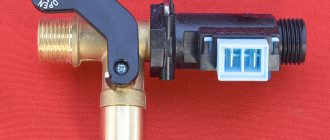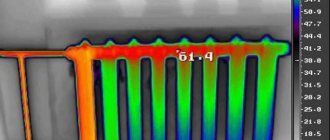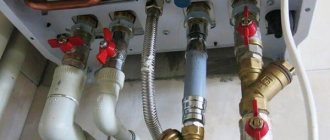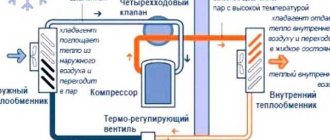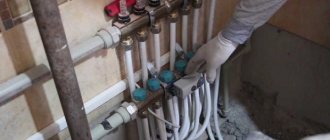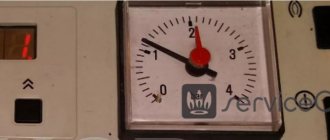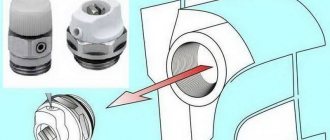Home / Heating
Back
Published: 02/25/2020
Reading time: 5 min
0
8911
The expansion tank in the heating system is designed to compensate for pressure drops in the coolant liquid that occur during starts and stops of the heating network. This phenomenon is explained by the thermal expansion of water or another coolant - antifreeze.
In order to perform its functions, the internal cavity of such a protective device is divided into 2 parts by a membrane - air and water.
The first has preset pressure parameters, which may drop during operation, so the user needs to know how to pump up pressure in the expansion tank of the boiler.
- 1 Design and purpose of the expansion tank
- 2 Correct pressure in the expansion tank 2.1 Norm for different models
- 5.1 Other troubleshooting methods
Gas boiler baxi eco four 24
A very popular series among all others in the BAXI line. The 4th generation boiler with a capacity of 24 kilowatts is available in various versions: with an open and closed combustion chamber. Boilers with a closed combustion chamber and forced smoke removal are designated by the letter “F” in the name. Baxi turbocharged boilers are the most popular and are often used when organizing apartment heating, so we will consider the use of an expansion tank in the heating system using this boiler model as an example.
Pumping the additional expansion tank with air.
When I added another heated floor mixing unit to the heating system, I took care of an additional 6-liter expansion tank.
The photo shows that a pipe goes to the expansion tank to the right.
If I need to add pressure to the system, I do the following:
1. Open the system filling valve.
2. I completely bleed the air from the additional expansion tank.
3. Close the system filling valve.
4. I pump up the expansion tank with a car pump to the required pressure.
Movement of coolant in the heating system
When organizing heating systems, various options can be used, but recently closed systems have become more popular, in which the coolant moves due to the operation of a circulation pump. A gas burner heats water (or antifreeze) in a primary heat exchanger, and a pump pumps it through a radiator system, transferring heat to the premises.
At the same time, for normal circulation of the coolant, the system must be completely filled with water, and since the liquid tends to expand when heated, it is necessary to somehow compensate for the increase in volume. This is why expansion tanks are provided in heating systems.
The diagram shows a system in which the boiler acts exclusively as a heater. In household wall-mounted boilers ECOFOUR, the expansion tank and circulation pump are already built-in, which is why such boilers are convenient to use in small apartments.
What should be the pressure in the heating system?
When organizing heating systems, various options can be used, but recently closed systems have become more popular, in which the coolant moves due to the operation of a circulation pump. A gas burner heats water (or antifreeze) in a primary heat exchanger, and a pump pumps it through a radiator system, transferring heat to the premises.
The diagram shows a system in which the boiler acts exclusively as a heater. In household wall-mounted boilers ECOFOUR, the expansion tank and circulation pump are already built-in, which is why such boilers are convenient to use in small apartments.
If you open the instructions, it indicates the pressure in the expansion tank is 0.5 bar, but this is the minimum value, correctly - the pressure should be about 20% less than the pressure in the heating circuit at room coolant temperature.
Based on the fact that for most systems the recommended filling pressure is in the range of 1.2 to 1.5 bar, we obtain the required pressure in the air cavity of the expansion tank equal to 0.8-1 bar. Experts usually recommend setting the pressure in the BAXI expansion tank to 1 bar.
Heating systems can be divided into two types - closed and open. When open, the pressure regulation function is performed by a leaky expansion tank.
The container is installed at the top point of the heating circuit and serves to hold the coolant expanding when heated, to remove air, and also acts as a safety valve. The operating pressure in such a system depends mainly on the temperature of the heating water.
Most often, when organizing heating in houses and apartments, closed heating systems are used. They are more effective and safe, but require constant pressure monitoring.
It is very important to monitor the pressure and temperature of the coolant, and respond to any signs that are not typical for the normal operation of the heating system - knocking, frequent discharge of hot water through the safety valve, cold sections of the circuit
The pressure in a closed-type circuit arises due to forced circulation carried out using a pump. Pressure deviations from the norm can lead to equipment failure.
The nominal pressure in gas boilers of different models may vary; it is determined by the technical characteristics of the equipment
When designing a heating system, the pressure is calculated taking into account the height of the water column, the length of the system, the characteristics of the connected equipment, and the cross-section of the pipes.
READ MORE: Norms of air humidity in an apartment and ways to measure it
To adjust the working pressure, you need to focus on the following parameters:
- Technical characteristics of a gas boiler. The manufacturer indicates the capabilities of the equipment and its settings in the instructions.
- Coolant temperature. The higher the temperature, the greater the pressure in the circuit; as it decreases, it decreases. Therefore, setting and measuring the pressure in the gas boiler and heating circuit must be carried out before and after heating the coolant.
- Volume of the circuit and expansion tank. The size of the accumulator has a direct impact on the pressure in the heating circuit and the range of its fluctuation.
- Acceptable pressure indicators for the least “weak” element of the system. The pressure in the system should not exceed the permissible values for each of its elements. For example, polypropylene pipes, which on average are designed for a pressure of 25 bar at room coolant temperature, can withstand an increase in pressure only up to 7-9 bar at a temperature of 90 °C.
The minimum pressure in the circuit can be 0.5-0.8 bar, the exact standard values are indicated in the instructions, in accordance with them the pressure sensor is adjusted to the required value. If the pressure in the heating system drops below 0.5 bar, an emergency situation occurs, in which the gas boiler may stop or be damaged.
The highest pressure value in the system is up to 3, less often up to 4 bar. For a five-story building, pressure values are adjusted to 5 bar, for a ten-story building to 7 bar. When making settings, it is necessary to adhere to the difference in pressure between the outgoing and return pipes - it should be 0.3-0.5 bar. After starting the heating, check if this is the case.
Design and location of the BAXI expansion tank
The baxi eco four 24 expansion tank is a red round tank located on the back wall of the boiler. The built-in expansion tank baxi with a volume of 6 liters is divided into two parts by an elastic membrane, one part is connected to the heating system, the second is pumped with air. Therefore, when the heating system heats up, the increasing volume of liquid overcomes the resistance of the membrane and fills the vacated volume of the tank, and when it cools, the membrane tends to move to its original position and pushes the liquid back into the heating system. Thus, the pressure in the heating system remains practically unchanged during operation.
Closed heating system from a water tower.
Occasionally, after using hot water for a long time, the error “insufficient water level” appears.
Or, if you changed something in the heating system and drained the water, air escapes through the air vents for some time.
So, the boiler turned off and gave an error, but it is impossible to add water - the water level in the tower is low.
The fact is that the water level in the water tower is not constant, but fluctuates between a minimum and a maximum.
The deep pump is switched on to fill the tower only when the water level reaches the minimum level sensor.
The tower is filled until the water level reaches the maximum sensor.
And, in order to fill the system to the pressure required to start the boiler, you need to wait until the water level in the tower drops to the minimum, the pump fills the tower to the maximum - only then can the pressure level in the system be brought to 0.8-0.9 bar.
What should be the pressure in the expansion tank of a BAXI double-circuit boiler?
If you open the instructions, it indicates the pressure in the expansion tank is 0.5 bar, but this is the minimum value, correctly - the pressure should be about 20% less than the pressure in the heating circuit at room coolant temperature.
Based on the fact that for most systems the recommended filling pressure is in the range of 1.2 to 1.5 bar, we obtain the required pressure in the air cavity of the expansion tank equal to 0.8-1 bar. Experts usually recommend setting the pressure in the BAXI expansion tank to 1 bar.
How to measure and adjust the pressure in the expansion tank
H2_2
The pressure in the heating system is controlled by pressure gauges, but the tank itself does not have a fitting for installing this device. However, there is a nipple in which a spool is mounted for pumping or releasing air. It is located on the side opposite the coolant supply. The nipple, in fact, is an analogue of a car pump, so to check this parameter or adjust it, you can use an ordinary car pump with a built-in pressure gauge.
1 Bar = 1 atm = 100,000 Pa = 0.1 MPa
Measuring pressure with a car pressure gauge:
- You need to turn off the boiler and wait 5-10 minutes until the system circulation completely stops;
- Close the shut-off valves in the area where the hydraulic tank is located. Drain the water through the drain fitting. If the membrane tank is built into the boiler, then the supply and return of the coolant are shut off;
- Unscrew the nipple cap and connect the pump to it;
- Pump air to 1.5 atm and wait until the remaining coolant flows out of the membrane tank, then release the air again;
- Shut off the shut-off valves and use a pump to bring the pressure in the membrane tank to the recommended pressure in the section above. If the tank is over-pumped, you need to bleed off the excess through the spool;
- Remove the pump, screw the cap onto the nipple and close the drain fitting. Open the shut-off valve and add water to the heating system through the make-up tap;
- It is easy to check whether the air pressure is adjusted correctly or not. When the boiler reaches operating parameters, the pressure gauge needle does not jump, the pressure builds up smoothly without jumps.
Do I need an expansion tank for a baxi wall-mounted gas boiler?
The volume of the built-in expansion tank of the baxi boiler is indicated in the characteristics and for the ECOFOUR series it is 6 liters. To answer the question of its necessity in a separate heating system, you need to know the total volume of this system.
Calculating it is not so difficult: the filling volume of the boiler and radiators is in their characteristics, and the filling volume of pipelines can be calculated by knowing their diameter and total length. Water, after heating by 80 degrees Celsius, will increase in volume by approximately 4-5%, therefore, the recommended volume of the expansion tank is 8% of the total volume of the heating system if filled with water and 12% if antifreeze is used as a coolant (thermal coefficient antifreeze expansion is greater). Thus, a standard expansion tank will be sufficient for a heating system with a volume of up to approximately 75 liters when using water and a volume of up to 50 liters when using antifreeze liquid.
These figures are conditional (with a margin) and when selecting the capacity of the expansion tank, you must be guided by the design calculations of a specific heating system, or the manufacturer’s recommendations.
In most cases, the built-in boiler tank is quite sufficient and the decision to use a separate additional tank is made by specialists at the design stage.
Specifications
| Indicators, units | NAVIEN Ace-13A Atmo | NAVIEN Deluxe-16K | NAVIEN Deluxe-20K | NAVIEN NCN-25K |
| Heating area, m2 | 98.0 | 128.0 | 160.0 | 220.0 |
| Condensing type | No | No | No | Yes |
| Thermal power, kW | 13.0 | 16.0 | 20.0 | 25.0 t |
| Combustion chamber | open (chimney) | closed (turbo) | closed (turbo) | closed (turbo) |
| Electrical power consumption, for own needs, kW | 110.0 | 150.0 | 150.0 | 130.0 |
| Min. t in the heating circuit, °C | 42 | 42 | 42 | 30 |
| Max. t heating circuit, °C | 80 | 80 | 80 | 95 |
| Max. pressure in the DHW system, bar | 8.0 | 8.0 | 8.0 | 10.0 bar |
| Max. t DHW, °C | 65 | 65 | 65 | 65 |
| Capacity (Δt=25°C), l/min | 9.0 | 13.6 | 13.8 | 14.0 |
| Capacity (Δt=35°C), l/min | 5.5 | 8.6 | ||
| Summer operating mode | Yes | Yes | Yes | No |
| Hot start mode | Yes | Yes | Yes | No |
| Efficiency, % | 86.0 | 91.0 | 91.6 | 98.2 |
| Nominal gas pressure in front of the boiler, mbar | 18.0 | 18.0 | 18.0 | 18.0 |
| Max. hourly gas consumption, m³/hour | 1.33 | 1.72 | 2.15 | 2.51 |
| Expansion tank capacity, l | 6.5 | |||
| Chimney diameter, mm | 130.0 | 60/100 | 60/100 | 80/125 |
| Price as of 07/01/2019 | 32780 rub. | 35200 rub. | 37880 rub. | 69800 rub. |
NAVIEN Ace-16K Turbo
Gas wall-mounted 16 kW is a compact design of a gas boiler for autonomous heating and hot water supply in houses with an area of up to 98 m2 with a remote control unit. Net power is 16 kW, average efficiency is 86%, and the highest fuel consumption is up to 1.33 m3/hour. DHW capacity - up to 5.5 l/min at t=35C.
Malfunctions of expansion tanks
Checking the pressure of the expansion tank is included in the list of annual maintenance procedures and if it is followed there will be no problems, but if neglected it can give the owner unpleasant surprises:
the pressure in the air chamber gradually decreases and with each refill of the boiler the tank fills more and more with water and gradually ceases to perform its function. In this case, the membrane is so pressed against the wall of the air part of the tank that it can be damaged by the valve spool and the tank will have to be replaced.
The heating circuit pressure is at the permissible limit, the expansion tank has not been serviced - there is no pressure in it. When the heating system cools down, the volume of liquid decreases, the pressure drop is not compensated for by anything - the boiler stops due to an emergency. This situation can arise, for example, when the boiler operates for a long time in DHW mode or when there is a power outage.
the owner of the boiler often has to top up the boiler for no apparent reason, for example, while hot water is being used - the pressure on the pressure gauge drops and the boiler stops by mistake - the owner tops up. Since thermal expansion is not compensated by anything, with further heating of the coolant, excess pressure is released through the safety valve. Some users set the reset and simply do not notice this situation. Frequently refilling the boiler with untreated water is detrimental to the heat exchanger!
Baxi boiler pressure drops when hot water is turned on
Sometimes, users encounter a problem when the pressure drops when turning on hot water in the baxi boiler. This problem may just be due to insufficient pressure in the expansion tank. The fact is that when the boiler switches to the hot water preparation mode, the circulation pump pumps the liquid in a small circle, i.e. only inside the boiler itself - through a secondary plate heat exchanger. In this case, the heating circuit actually does not heat up and the coolant begins to cool, the volume decreases and in the absence of compensating pressure in the expansion tank, the pressure of the heating system may drop and the boiler will display error E10.
In such a situation, you can also consider the possibility of a breakdown of the heat exchanger itself (a gap between the plates) and water from the heating circuit entering the hot water system, but this is easy to check. To check, you need to shut off the cold water supply to the boiler and open any drain valve. If under such conditions water comes out of the tap, it is obvious that this is coolant from the heating circuit and the heat exchanger needs to be replaced.
Remember, timely maintenance of a gas boiler will help avoid such situations and increase the service life of the unit.
We also recommend watching a video from one of the users, which clearly shows how to pump up pressure in the expansion tank:
The expansion tank in a heating boiler performs an important function - it compensates for pressure surges when the temperature values of the coolant change, be it ordinary water or antifreeze. The tank itself consists of two parts, between which there is a membrane. One part contains the coolant, the other contains air, through which the required pressure is created. And for normal operation you need to periodically pump up the tank. Next, you will learn how to pump up the boiler expansion tank and how to detect when you need to do so.
A common situation: you turn on the water and run a bath. At this time, the boiler switches from heating mode to hot water supply mode. While the water is being collected, the coolant gradually cools down, and the expansion tank does not function at this time. And when you turn on the tap, the boiler should start heating again, but this does not happen. The reason is a sharp drop in pressure, as a result of which the automation simply blocked everything. This means it's time to pump up the air and increase the pressure in the tank.
Reasons for increasing pressure in the system
Sometimes, when checking the pressure in a closed heating system, the home owner may notice an increase in the indicators.
The reasons for the increase in pressure are:
- the coolant temperature in the circuit is too high, which has led to its excessive expansion;
- For some reason the water stopped moving along the contour;
- a valve is closed on one of the pipeline sections;
- an air lock or mechanical blockage has formed;
- the tap is not closed tightly, as a result of which water is constantly added to the boiler;
- the cross-section of the pipe entering and exiting the boiler does not meet the requirements;
- the pump power is higher than necessary, or it is not working correctly; problems with the pump can lead to water hammer inside the circuit.
Thus, it is important to find out what exactly caused the increase in pressure and solve the problem. Sometimes, in an efficiently operating system, a sharp surge in pressure occurs with the pressure gauge needle moving into the emergency zone. The reason for this is most likely that the water in the boiler has boiled. In this case, the fuel supply should be minimized as quickly as possible.
Most modern boilers for heating private houses have an expansion tank. This is a special sealed block, divided inside in two by a rubber partition. One compartment contains air, and the second contains hot water. If the water temperature is too high, the pressure increases and moves the baffle in the expansion tank to increase the size of the water reservoir and compensate for the difference.
In addition, boilers are equipped with safety relief valves, which are activated when the coolant boils or a critical pressure surge. They can be located either in the expansion tank or on the pipe leaving the boiler. When the maximum pressure in the heating system is reached, excess coolant is poured out through the valve, preventing damage to the circuit.
With proper design, bypass valves can be provided in the heating system. They allow you to redirect the coolant to a small circuit when a gap or air lock forms in the main circuit. This measure allows you to avoid overheating and breakdown of the heating system.
The performance of the components of the heating system must be periodically checked, since coolant leaks and violation of normal pressure levels in the expansion tank can lead to significant fluctuations in pressure in the circuit.
How to pump air into the boiler expansion tank?
Please note that you will not be forcing air into the system itself, but only into the expansion tank. Accordingly, it is not advisable to look at the boiler pressure gauge. Your main reference point is the pressure gauge on the pump itself. You can use a regular pump that is used to inflate car tires. You can, of course, use a compressor. Although not necessary. Your task is to pump up the pressure to just 1 atmosphere. An ordinary pump will handle this quite well.
The upload process consists of four steps:
- First, unplug the system and remove the plug from the outlet. This will primarily keep you safe.
- Next, drain the water from the boiler. If the equipment is new and installed correctly, then there is no need to drain all the water. It is enough to turn off the cold water supply, open the hot water supply tap, and also open the hot water supply valve on the closest mixer. This way the water contained in the boiler will be completely drained. Most modern boilers have special fittings for draining water. You can use them, but it is inconvenient - you will have to drain the water into buckets, basins, large bowls, then pour it out and repeat the procedure. The first method is faster and easier. Draining water from a gas boiler is necessary to make sure that you will pump air into the expansion tank. If there is any water left in it, it will be ineffective.
- Pump up the tank. Each tank has a regular nipple to which the pump can be easily connected. In most cases, you do not have to remove the boiler lid to access the nipple. When you pump up the tank, constantly monitor the pressure gauge on the pump. Your task is to pump up to approximately 1.2 atmospheres. This is the optimal value. If it turns out more, you need to loosen it. Otherwise, the system may simply not work until the pressure returns to normal. If you see water still coming out of the faucet while pumping, this is normal.
- Connect the boiler. When the pressure in the expansion tank reaches normal, you can reconnect the boiler. First, close the water supply tap and open the cold water tap. At the same time, dirty water and air bubbles will begin to flow. When this stops, the tap can be closed. Next, the feed tap must be opened again to fill the boiler to its operating condition. Here you need to look at the pressure gauge located on the body.
After this, you can open the supply and return taps. If you see that the pressure is weakening, you can add water. Next you need to remove air from the pump. Unscrew the plug at its end and bleed the air in the same way as is done on Mayevsky taps.
An important question for owners of wall-mounted and floor-mounted heating boilers: “how often do you need to pump up the expansion tank?” We recommend doing this every two years in new boilers, and every year in boilers that have already been in service for several years. Optimally - before the start of the heating season.
How to identify a malfunction and why does the pressure in the expansion tank drop?
The most common signs of malfunction:
- “Jumping” pressure during boiler operation. For example, when the system operates for heating, it increases, and when switching to hot water supply it decreases. In the latter case, the indicator may even drop to zero.
- You have to constantly recharge the heating system, although leaks cannot be detected, and the heat exchanger works normally. Often the problem arises when there is a heated floor in the house.
In some cases, the reasons for the drop in pressure can be discovered independently. Very often they arise precisely because of coolant leaks. Moreover, more often when using antifreeze as a coolant. Antifreeze, due to its consistency, can penetrate even the smallest cracks, and the pressure drops. To correct the situation, you need to find the leak and fix it, then pump up the tank to the required pressure.
During operation, the pressure in the boiler itself may drop and return to normal after startup. If it does not align, this is a sign of a malfunction. Further, the system will fail even more. In such a situation, it is best to immediately contact a specialist for diagnostics, service and repair.
If you need boiler repair or maintenance, call Profteplo
We work in Kaluga and the region, diagnosing, servicing and repairing systems of any complexity. We carry out both simple tasks of pumping air into an expansion tank, and complex complex repairs of modern systems. We provide a guarantee for all types of work.
If you need advice or want to use the service, just call the number or leave a request directly on the website. The master will arrive on the day of your call and will perform all the necessary types of work.
The expansion tank in a heating boiler performs an important function - it compensates for pressure surges when the temperature values of the coolant change, be it ordinary water or antifreeze. The tank itself consists of two parts, between which there is a membrane. One part contains the coolant, the other contains air, through which the required pressure is created. And for normal operation you need to periodically pump up the tank. Next, you will learn how to pump up the boiler expansion tank and how to detect when you need to do so.
A common situation: you turn on the water and run a bath. At this time, the boiler switches from heating mode to hot water supply mode. While the water is being collected, the coolant gradually cools down, and the expansion tank does not function at this time. And when you turn on the tap, the boiler should start heating again, but this does not happen. The reason is a sharp drop in pressure, as a result of which the automation simply blocked everything. This means it's time to pump up the air and increase the pressure in the tank.
How to pump air into the boiler expansion tank?
Please note that you will not be forcing air into the system itself, but only into the expansion tank. Accordingly, it is not advisable to look at the boiler pressure gauge. Your main reference point is the pressure gauge on the pump itself. You can use a regular pump that is used to inflate car tires. You can, of course, use a compressor. Although not necessary. Your task is to pump up the pressure to just 1 atmosphere. An ordinary pump will handle this quite well.
The upload process consists of four steps:
- First, unplug the system and remove the plug from the outlet. This will primarily keep you safe.
- Next, drain the water from the boiler. If the equipment is new and installed correctly, then there is no need to drain all the water. It is enough to turn off the cold water supply, open the hot water supply tap, and also open the hot water supply valve on the closest mixer. This way the water contained in the boiler will be completely drained. Most modern boilers have special fittings for draining water. You can use them, but it is inconvenient - you will have to drain the water into buckets, basins, large bowls, then pour it out and repeat the procedure. The first method is faster and easier. Draining water from a gas boiler is necessary to make sure that you will pump air into the expansion tank. If there is any water left in it, it will be ineffective.
- Pump up the tank. Each tank has a regular nipple to which the pump can be easily connected. In most cases, you do not have to remove the boiler lid to access the nipple. When you pump up the tank, constantly monitor the pressure gauge on the pump. Your task is to pump up to approximately 1.2 atmospheres. This is the optimal value. If it turns out more, you need to loosen it. Otherwise, the system may simply not work until the pressure returns to normal. If you see water still coming out of the faucet while pumping, this is normal.
- Connect the boiler. When the pressure in the expansion tank reaches normal, you can reconnect the boiler. First, close the water supply tap and open the cold water tap. At the same time, dirty water and air bubbles will begin to flow. When this stops, the tap can be closed. Next, the feed tap must be opened again to fill the boiler to its operating condition. Here you need to look at the pressure gauge located on the body.
After this, you can open the supply and return taps. If you see that the pressure is weakening, you can add water. Next you need to remove air from the pump. Unscrew the plug at its end and bleed the air in the same way as is done on Mayevsky taps.
An important question for owners of wall-mounted and floor-mounted heating boilers: “how often do you need to pump up the expansion tank?” We recommend doing this every two years in new boilers, and every year in boilers that have already been in service for several years. Optimally - before the start of the heating season.
How to pump air into the expansion tank of a Baxi gas boiler?
Pumping up the expansion tank should only be done when the boiler is empty!
Therefore you need to do the following:
- Turn off the heating system taps
- Drain the water from the boiler through the drain valve
- Inflate the tank to the required pressure
- Close the drain valve
- Feed the heating system through the make-up tap
- Open the heating circuit taps
The air cavity of the expansion tank is equipped with a valve for carrying out technical
service. The valve design is a regular car nipple, so the easiest way to pump the expansion tank of a baxi boiler is to use a tire pump - manual or electric car. The latter is convenient because it has a pressure gauge to control the pressure, but often the boiler is located in cabinets or niches and it is not always convenient to get to it, so it is preferable to pump it up with a hand bicycle pump, and then check the pressure with a car pressure gauge and, if necessary, bleed off excess.
How to identify a malfunction and why does the pressure in the expansion tank drop?
The most common signs of malfunction:
- “Jumping” pressure during boiler operation. For example, when the system operates for heating, it increases, and when switching to hot water supply it decreases. In the latter case, the indicator may even drop to zero.
- You have to constantly recharge the heating system, although leaks cannot be detected, and the heat exchanger works normally. Often the problem arises when there is a heated floor in the house.
In some cases, the reasons for the drop in pressure can be discovered independently. Very often they arise precisely because of coolant leaks. Moreover, more often when using antifreeze as a coolant. Antifreeze, due to its consistency, can penetrate even the smallest cracks, and the pressure drops. To correct the situation, you need to find the leak and fix it, then pump up the tank to the required pressure.
During operation, the pressure in the boiler itself may drop and return to normal after startup. If it does not align, this is a sign of a malfunction. Further, the system will fail even more. In such a situation, it is best to immediately contact a specialist for diagnostics, service and repair.
